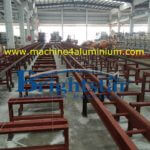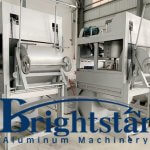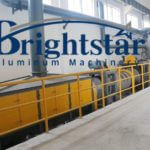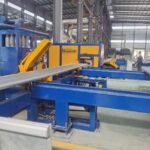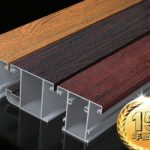Dross Processing in India Growing Opportunities
Dross Processing in India Growing Opportunities
Dr. M. Nilmani & Mr. H. T. Makhijani
NCS (Australia) HTMA (India)
Abstract:
As the aluminium industry in India is rapidly expanding, both primary as well as secondary industries are gearing up to producing or processing larger volumes of aluminium metal. Increasing domestic and imported scrap will further add to this existing volume to remelt units. High cost of melt loss, environmental concerns and maximizing metal recoveries shall be key driving factors for Indian aluminium primaries as well as secondaries to implement better methods, work practices and technology. This paper looks at the current & future challenges relating to dross processing & handling in Indian Primary & Secondary Industry.
Introduction:
Metal loss as dross during the melting of aluminium is and should be a major concern to all aluminium producers and remelters. Cost reduction, the preservation of metal units and environmental awareness all make limiting dross formation during the melting process a major goal for cast houses and remelt centers. Dross handling and processing to recover metal is equally important. Few decades ago what was considered normal recovery of 30% of dross weight will not be accepted today. With current technology over 65% will be expected as the minimum return of metal from a given dross weight. All this has been possible as a result of continuous developments in the technology to meet the environmental concerns, energy conservation, profitability and community impact for the sustainability as shown in Fig. 1 for long term sustainability of the industry the triple bottom line concept will be essential.

sustainability concept
Technology Gap
The fast expansions in the Indian aluminium industry due to strong economy, major infrastructure projects in pipeline, huge developments in the automotive sector and increased building constructions will continuously increase the domestic demand for Cast, rolled & extrusion products. The rapid pace of this expansion is creating a technology gap, where industry presently used to traditional methods need to change its mind set and invest in the state of the art technology to stay competitive. The present practices of melting, melt handing and dross processing in India have not yet adopted current technology. This technology gap (Fig. 2) needs to be filled to meet the triple bottom line for a sustainable industry.

FIG 2
Current Metal Production & Processing
At present the Indian Aluminium Industry, both in Primary as well as in Secondary, has production / processing capacity of close to Two Million Tons. Primary Smelters – Nalco, Hindalco and Balco produced around one million tons on average in last two years.
Secondary Industry including the following processors produced over 700,000 tons of aluminium for different end uses.
Aluminium Conductor Units
Pressure Die-Casting Units
Foil Plants
De-Oxidising Agents Producers
Aluminium Vessels / Pressure Cookers Producers
Recycling Unit (At Taloja – Capacity : 30 000 TPA)
Secondary Alloy Producers, etc.
Extrusion Units

Aluminium metal production
In the next five years with the current green field and brown field expansions, it is anticipated that the production levels will be more than double as indicated in Table 1.Reducing import tariff will further increase availability of metal / scrap for the secondary industry.
Metal Loss and Dross Generation
In India conservative estimates of the dross produced is 120,000 tons, based on dross produced from various sectors i.e. 1-2% from primary smelters, contaminated light section scrap 6-10% and machine turnings (unbaled, oxidized) in excess of 15%. Minimizing this quantity will bring a big gain to the plants. The quantity of metal in dross will vary from operation to operation in the range 15% to 70%. Efficient recovery of this metal will bring big gains to the operation. As per estimates the quantity of dross available for processing will be more than double by the end of year 2010 as shown in table 1.
In India both in Primary as well as in Secondary Industries dross is often sold to outside agencies either against payment or alternatively on “Toll” basis. Based on discussions following information was collected to give indication to the current state of secondary industry.
Industry Practice – Key Issues
This section will address issues relating to the current practices that need attention to become efficient. Large gains are to be made with improved changes made to the system.
Melting Practice:
Furnace Operation
Pouring Temperature
Scrap Charging
De-coating & submerged melting
Burner Control
Door Seals Leakages Positive Pressure
Both the organized and unorganized secondary sectors are increasing their presence in aluminium recycling.
According to the published figures and discussions with the importers about 80,000 tons per annum scrap is imported and processed in India. The volume is on rise. In addition over 320,000 tons of scrap is collected and recycled within the country. All types of scraps are processed UBC, Scrap from machine shop, Cables, conductors, foundry and many other places like wise.
Scrap Melting:
Obviously, the thinner the gauge, the greater is the surface area (per unit weight of charge) exposed to the furnace environment. Hence the quantity if surface oxide film formed is greater for thinner gauges (Fig. 3). Oxidizing furnace atmosphere, direct flame impingement and excessive temperature will increase oxidation. Therefore fine scrap should be charged submerged either under the metal heel in a reverberatory furnace or through a vortex created by a suitable rotor.
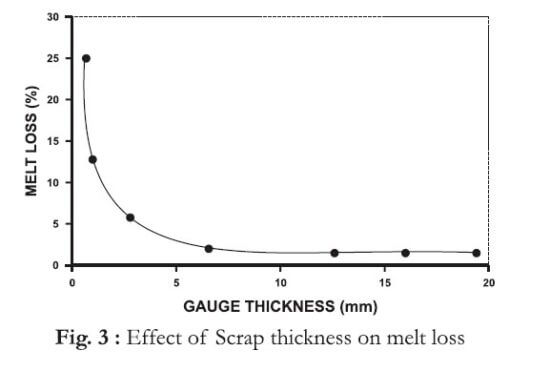
Effect of scrap thickness on melt loss
Chemical composition of charge is very important in affecting oxidation kinetics. When the oxide layer is dense, continuous & protective, oxidation falls rapidly after the oxide skin is formed. Conversely when the skin formed is porous, the oxidation continuous. Alloying elements Mg, Ca, Na, and Li are known as oxide formers and cause aluminium melt to dross at a rapid & continuing pace (Fig. 4). The principal alloying element which will act in this way is Mg. Therefore “high Mg” alloys eg 5182 and 5152 will form more dross than low Mg alloys such as 1100 and 3004.
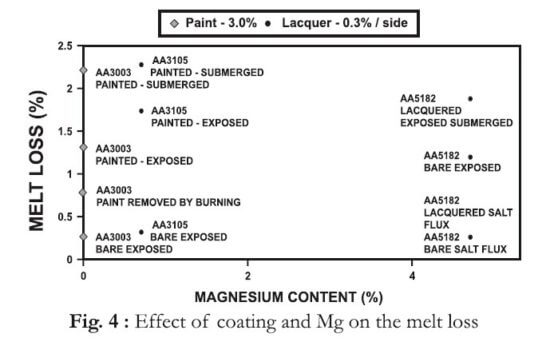
Effect of coating and Mg on melt loss
Contaminants
Scrap may carry a coating of paint or lacquer (e.g. UBC), or contain cutting oils or rolling lubricants. These nonmetallic organics have an appreciable effect on melt loss. If the scrap is charged to a ‘dry hearth’ (i.e. no pre-existing melt), the volatiles will burn readily, prior to the melt forming. Hence there is little effect on dross generation. However, if the painted scrap is directly submerged, the volatiles generated will take part in metal oxidation. Therefore decoating is recommended for the coated scrap.
The oxidation rate of A-! varies with temperature and holding time of the melt. The initial oxide that forms is protective and keeps the oxidation rate to low level. After a certain induction period (which depends on temperature, alloy composition and atmospheric conditions), the protective nature of the oxide skin is lost and a phenomenon known as ‘breakaway oxidation’ occurs. Fig. 5 shows when this breakaway condition occurs for a various holding temperatures.
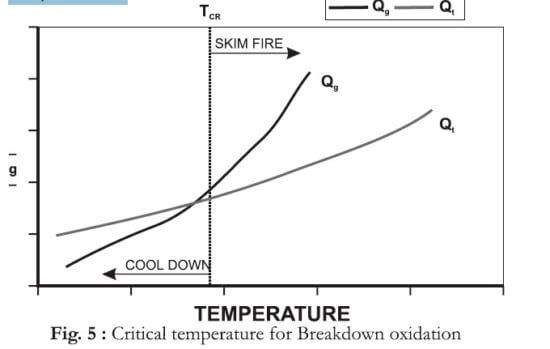
Critical temperature for breakdown oxidation
Both in Primary as well as Secondary plants it has been observed that the metal temperature in Holding Furnaces is often higher than necessary – often due to large drop in temperature in Launders. This leads to conditions where thermiting starts and metal is oxidized at the faster rate. Temperature of the bath goes out of control leading to huge dross formation. Use of preheated launders with insulating covers is recommended to reduce metal pouring temperature. Whereas Primary Industry by and large is well provided with temperature measurement instruments, the Secondary Industry often lacks basic instrumentation to measure temperature correctly. This results in higher metal temperatures.
Many places furnace doors are not well sealed, leading to heat losses. To compensate the burners are run high resulting air ingress & insufficient control of burners make the furnace a dross generator. Having a small positive pressure inside the furnace will prevent the ingress of air. Heavy firing and/or direct flame impingement can cause thermiting of the dross layer. If the burner is of high velocity, direct impingement can cause surface turbulence which will create further dross. Emphasis must be placed on the melt transfer without turbulence and using degassing, fluxing, temperature homogenizing devices that do not create surface turbulence.
Skimming practice is often not looked after carefully. Huge amount of metal is caught up with the dross. Boom design and operator skill becomes important to control this loss from the furnace bath.
Metal Recovery from the Hot Dross
If the dross removed from the furnace, it left in front of the furnace and it will fume and pollute. This process is further accelerated by thermiting leading to direct loss of metal by oxidation. In the primary operations hot dross from the furnace is collected into drain pan mounted below the skim pan. Up to 20% of metal is recovered in the drain pan in case of smelter dross.
There are various methods employed for higher metal recovery
Cool dross as fast as possible to stop fuming & thermiting
Cool under reducing atmosphere to stop oxidation
Use of Dross Press
Agitate the hot dross vigorously to get metal out
Air cooling is commonly practiced in India by spreading hot dross on shop floor or leaving it in thick steel pans where it cools slowly while thermiting and fuming continues. If thermiting is not controlled total metal in the dross can turn to waste (oxide), as shown in Fig. 6
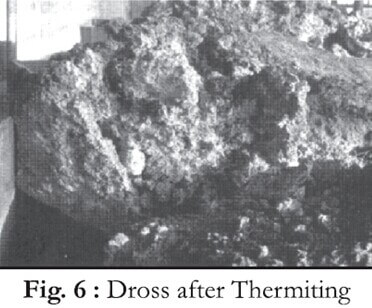
Dross after Thermiting
Drum coolers have been employed by the primary industry world over. However, its popularity is going down as new processors are emerging. Drum cooler is a double jacketed slanted rotating barrel slowly spinning on its horizontal axis. Hot dross enters from one end and cools down by the time it discharges out. Cooled dross is classified and concentrated in various size fractions. Large fraction rich in aluminium is recycled back in-house while finer fractions is used in other applications such steel deoxidizer.
In recent years use of dross press has become popular.
Dross Presses have been used widely in foreign countries to cool hot dross and obtain maximum in-house recoveries. Since the cooling cycles are very short – often no more than a few minutes – further thermiting of the dross is prevented. Hence metal recoveries are comparatively high.
The Process is environmentally friendly since quick cooling action eliminates fumes generation and the left over dross -as hard pressed skull is easy to handle / transport than dross with fines.
Recovery of Metal from Dross
Current practices in India are more towards coal or gas fired crucible furnaces of various sizes ranging from 50kgs to 250kgs. These operations are inefficient and questionable environmentally. Rotary salt furnaces are also used. Both use a salt mixture of NaCI & KCI to submerge dross and release aluminium from oxides. The major problem with this technology is the safe disposal of salt slag. To minimize the use of salt, new processes have been developed.
Tilting rotary furnace is one of them. These furnaces use one fourth of the salt used by normal salt furnaces and employ oxy-fuel burners to speed up the heating cycle and control the temperature to maximize metal release without metal loss. Besides higher recoveries as high as 88 to 93%,a reduction of more than 50% in the flue gas volumes brings less load and keeps low temperature of the bag house. Tilting Rotary Furnaces are available in various sizes to process 5000 tons to 20,000 tons of Dross per year.
Zero Waste
Though the unorgainsed industry sector may use many primitive technologies, it has not stopped them to be creative to find maximum recovery of aluminium from the dross to the extent of extracting all f r o m t h e dross to take it to the zero waste as shown in Fig. 8.
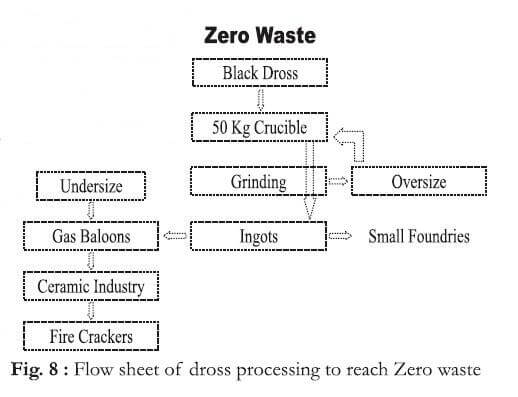
Flow sheet of dross processing to Zero waste
Conclusion
With major expansions in the aluminium industry now, there are many opportunities to improve melting and melt handling practices in order to minimize dross formation. A few areas in which increased melting yields can be achieved include scrap preparation, submerged charging, furnace design, burner operation and charging practice.
Currently India is processing substantial quantities of scrap that results in excessive dross formation. There is a scope for employing new technology to minimize melt loss, improve metal recovery from dross by using tilting rotary furnace technology and meet environmental needs.
This article is published on June 2006 on Metal world and I think it still can be used as reference for India dross processing!

